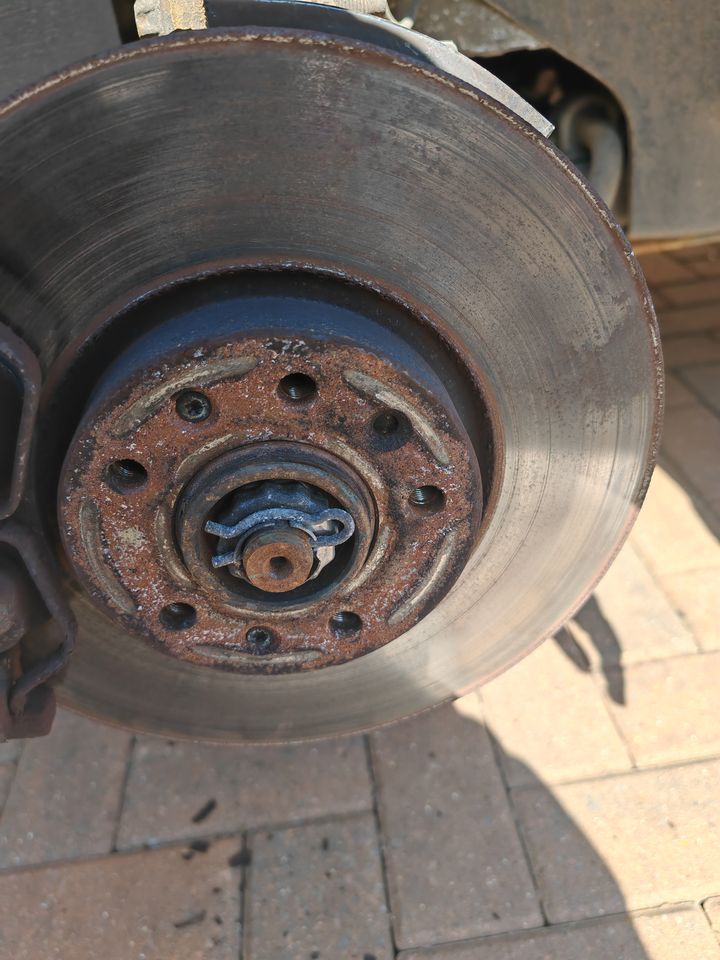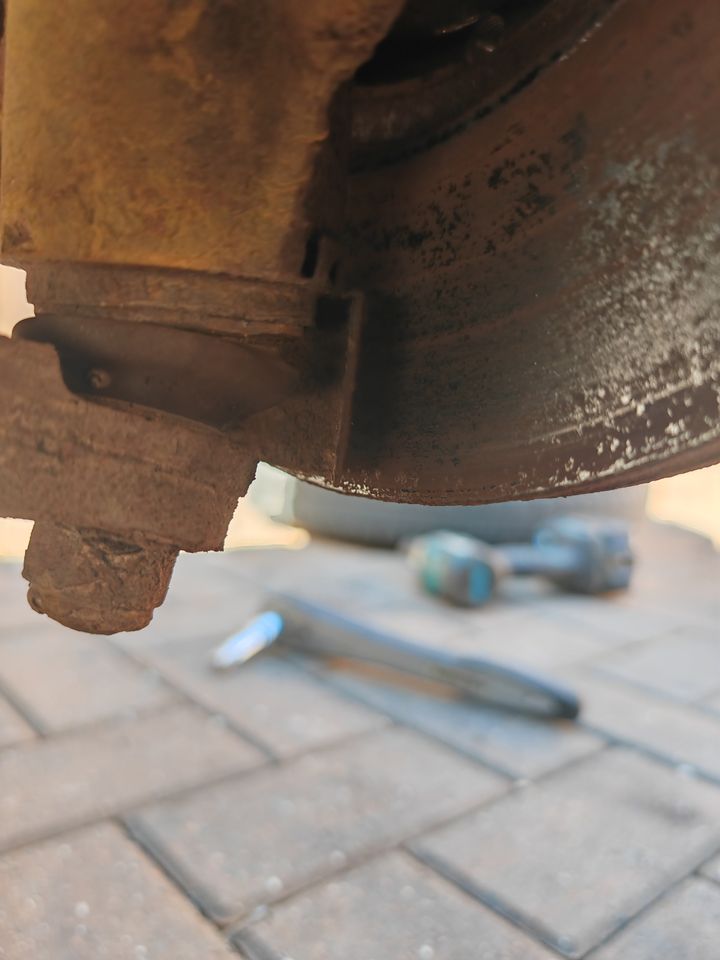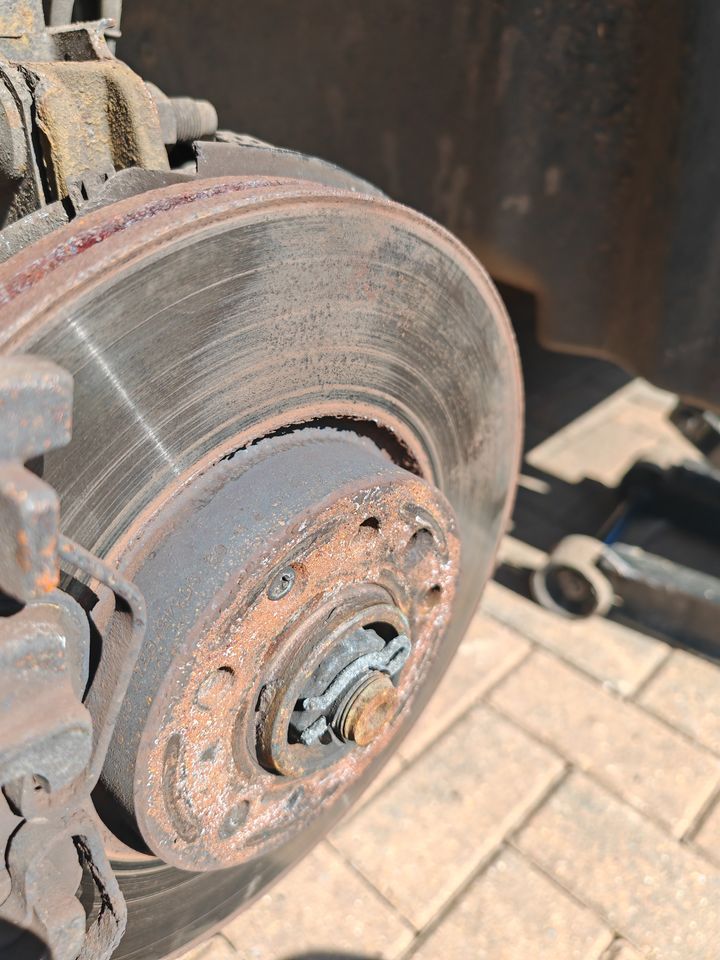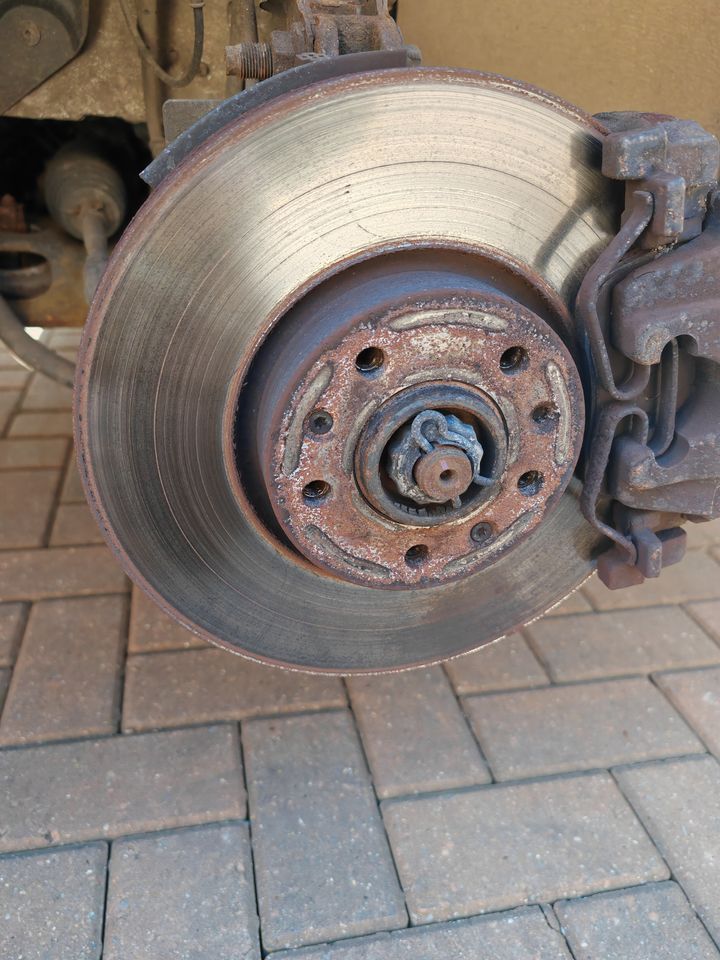Severe brake judder...
Discussion
I'm getting brake judder on pedal and steering wheel (but mostly on pedal). Doesn't matter if it's low speed or high. It's really bad.
Discs and pads replaced 2 years ago at main dealer by last owner.
I've got as far as removing each wheel and inspecting each disc and I have to say, they are in poor condition. All of them really. The fronts also have pads that are 5mm more worn than the other side. Thoughts on the culprit?




Discs and pads replaced 2 years ago at main dealer by last owner.
I've got as far as removing each wheel and inspecting each disc and I have to say, they are in poor condition. All of them really. The fronts also have pads that are 5mm more worn than the other side. Thoughts on the culprit?
ssray said:
Wrong forum section
Seized calipers , rebuild or use refurbished ones . If your bothered you could see if the discs have enough meat to have them machined and replace the pads as they have probably overheated
How sure are you they are seized? And which ones? I've jacked it up and they spin fine.Seized calipers , rebuild or use refurbished ones . If your bothered you could see if the discs have enough meat to have them machined and replace the pads as they have probably overheated
Or do you mean sticking calipers?
If pad wear is uneven from side to side, its a sure sign the caliper is seized (on the side with the least wear). Judder also means I'd be swapping the discs too, even though they're not worn out, because they're probably warped now.
And don't buy the components from Temu, unlike the last person who worked on it.
And don't buy the components from Temu, unlike the last person who worked on it.
Ok, are you at all handy with the spanner’s and able to do any work yourself, is so and this was me the first thing I would do is change out those discs and pads, the inner face of the discs are quite badly corroded and some of that rust looks to have scabbed, that’s not going to come off with normal braking and can cause the symptoms you describe. It can also cause uneven brake pad wear. I would then take it from there.
davidexige said:
Ok, are you at all handy with the spanner’s and able to do any work yourself, is so and this was me the first thing I would do is change out those discs and pads, the inner face of the discs are quite badly corroded and some of that rust looks to have scabbed, that’s not going to come off with normal braking and can cause the symptoms you describe. It can also cause uneven brake pad wear. I would then take it from there.
I can do majority of jobs no problems. Are you saying all discs and pads?
Might be worth pricing new calipers depending on the car. They're surprisingly cheap sometimes. Certainly discs and pads, I wouldn't be bothering trying to salvage that mess. I'd want to know the source of the problem though, so I'd have a good look at the old calipers regardless of whether I was keeping them or not.
I'd also clean up the mating faces on the hubs and backs of the wheels, that can't be helping. They need to be spotless really to eliminate that as a potential cause of any judder or wheel shake. I speak from experience if you have a look at my recent posts on my Evo thread in Readers cars.
I'd also clean up the mating faces on the hubs and backs of the wheels, that can't be helping. They need to be spotless really to eliminate that as a potential cause of any judder or wheel shake. I speak from experience if you have a look at my recent posts on my Evo thread in Readers cars.
That inner Pad is doing nothing imho. Most likely means the inner Pad is jammed in the Caliper as the outer is doing all the work.
What does the inside of the other disc look like?
Also, what's your mileage per year/ when did you last use the vehicle?
Those discs look like they've stood for a fair while as well.
For the cost, I'd bin the lot and check for jammed caliper sliders. The jammed inner Pad will show itself on replacement.
ToMeToYou said:
I can do majority of jobs no problems.
Are you saying all discs and pads?
If it's juddering with no obvious signs of suspension issues then the discs are almost certainly already tatered. They certainly don't look great too.Are you saying all discs and pads?
You could try rebuilding the calipers first then replacing the discs as a minimum if the judder is still there but it almost certainly will still be there
Before you start throwing parts at the car, there's possibly nothing wrong with the calipers at all. When the piston in a sliding caliper is 'seized', it will wear both pads simultaneously. By all means check that the piston moves freely with a couple of pumps on the pedal (no more), pull back the dirt boot and have a look at the piston if you can, and of course judge how smoothly it returns. I always eject this fluid through the nipple rather than forcing dirty fluid uphill and back through the ABS valves; clamp the hose to ensure this.
A far more common problem is for the pads to be 'seized' in their carriers; it is essential when changing pads that the carriers are removed, held in a bench-vice, and all the contact areas for the pad ears to be cleaned back to bright metal. This is a fag, and most mechanics cannot be arsed to do it. Some even grind the pad to fit the build up of crud in the carrier! Clean the carrier, give the contact areas a lick of some sort of grease (some say ceramic is best, others use a copper based one, but it's more to delay corrosion tbh), clean and lubricate the slide pins (silicone grease is best). After reassembly, but before pumping the pedal to advance the pads to the disc, check that the caliper is free to slide from side to side, and that you can feel & hear some sort of resistance on the disc when you do so.
In your case, those discs and pads need changing, that's shocking condition for only two years, and then you need to get out and use it more!
A far more common problem is for the pads to be 'seized' in their carriers; it is essential when changing pads that the carriers are removed, held in a bench-vice, and all the contact areas for the pad ears to be cleaned back to bright metal. This is a fag, and most mechanics cannot be arsed to do it. Some even grind the pad to fit the build up of crud in the carrier! Clean the carrier, give the contact areas a lick of some sort of grease (some say ceramic is best, others use a copper based one, but it's more to delay corrosion tbh), clean and lubricate the slide pins (silicone grease is best). After reassembly, but before pumping the pedal to advance the pads to the disc, check that the caliper is free to slide from side to side, and that you can feel & hear some sort of resistance on the disc when you do so.
In your case, those discs and pads need changing, that's shocking condition for only two years, and then you need to get out and use it more!
Edited by TwinKam on Thursday 10th April 09:18
The discs and pads area dead and need replacing - but the reason for that is that the previous person to throw brakes on it, put zero effort into maintenance of the caliper.
Sliding caliper will probably have a corroded piston, and gummed up/dry/corroded sliding pins. Caliper is jammed up, inside pad doing bugger all.
Needs a dose of looking at, and for many cars, replacement rebuilt calipers from your local motor factors (often on an exchange basis) are very cheap, often cheaper or close to the cost of just buying a rebuild kit - so just change them. They'll be in a lovely fresh silver or gold galv finish too.

The brakes will feel, and operate, infinitely better afterwards. Fresh bleed too.
Sliding caliper will probably have a corroded piston, and gummed up/dry/corroded sliding pins. Caliper is jammed up, inside pad doing bugger all.
Needs a dose of looking at, and for many cars, replacement rebuilt calipers from your local motor factors (often on an exchange basis) are very cheap, often cheaper or close to the cost of just buying a rebuild kit - so just change them. They'll be in a lovely fresh silver or gold galv finish too.

The brakes will feel, and operate, infinitely better afterwards. Fresh bleed too.
TwinKam said:
Before you start throwing parts at the car, there's possibly nothing wrong with the calipers at all. When the piston in a sliding caliper is 'seized', it will wear both pads simultaneously.
A far more common problem is for the pads to be 'seized' in their carriers
Point one is true in theory but in practice it means a brake with too little clearance (or drag if it’s bad enough) which means it will get hot and cause runout and/or the pads will touch the disc at the higher runout points and cause disc thickness variation which is the usual cause of judderA far more common problem is for the pads to be 'seized' in their carriers
Point two is good advice, it is worth checking if the pads are jammed
E-bmw said:
If the piston in a sliding calliper is seized it will surely wear neither pad as it doesn't push the pads onto the disc.
Usually, when pressure is removed the piston would retract slightly due to spring in the seals, bearing run-out and so on. I don't know whether this is what the other poster had in mind, but if the piston is sticking but not seized solid then it may extend when pressure is applied but not retract when it's removed, iyswim. The result would be a caliper that drags, causing heat and wear.Gassing Station | Suspension, Brakes & Tyres | Top of Page | What's New | My Stuff



